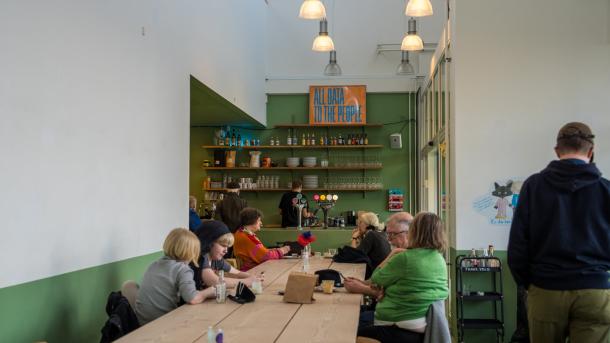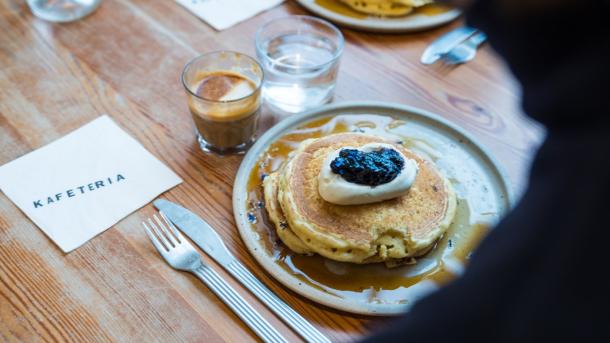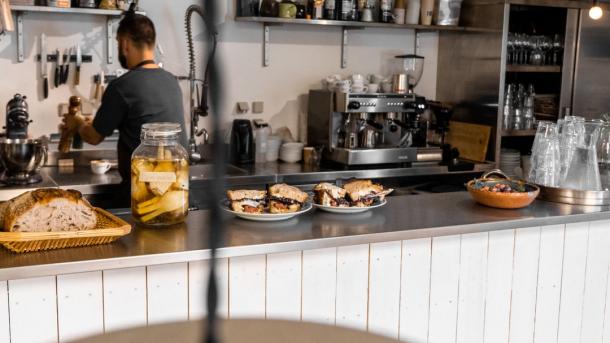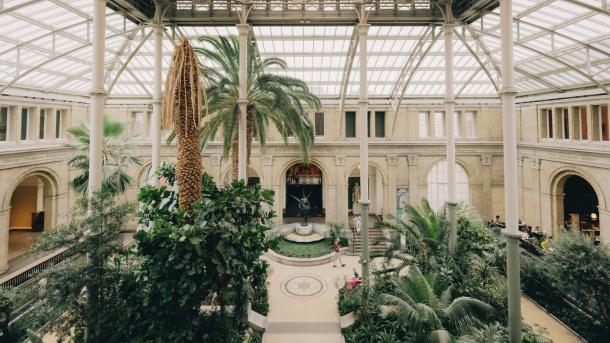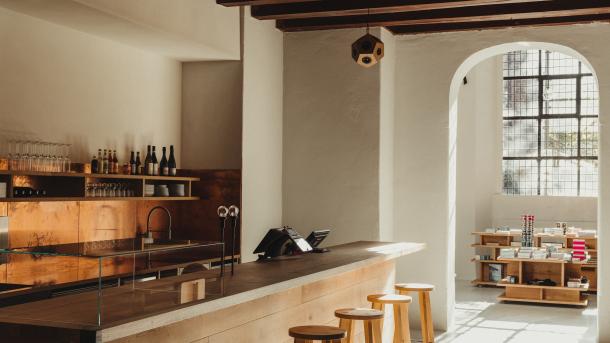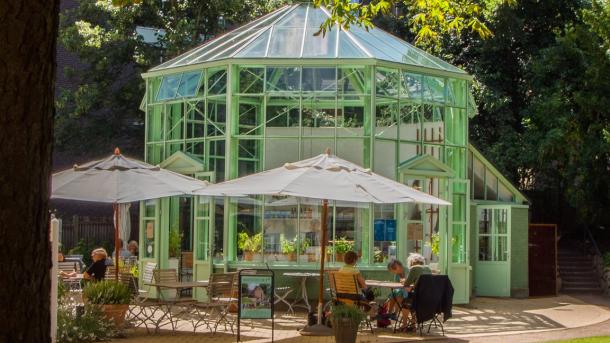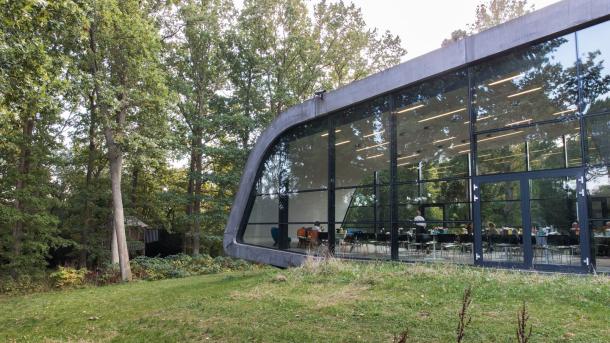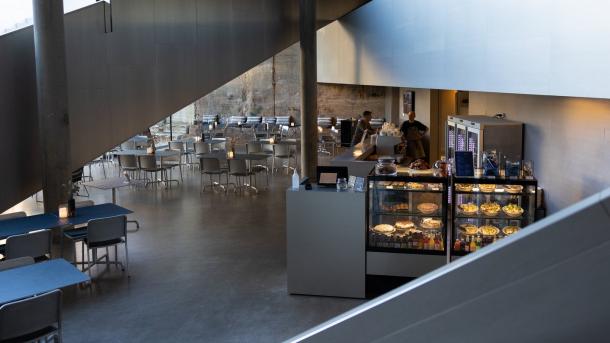
Gastronomy and culture – Why Copenhagen’s museum cafées stand out from the crowd
Top chefs, unique interior and Nordic-inspired meals. The Copenhagen museum cafées excel in both quality and creativity.
Copenhagen is not only a capital of high-level gastronomic experiences but also a capital with great cultural offerings.
In the last couple of years, museums in Copenhagen have focused on elevating their cafés, relaunching their concepts, and making a visit to a museum a more wholesome cultural experience.
The food options in Copenhagen museums range from high-end bakeries to lunch cafés, restaurants, and wine bars. Experts from the Copenhagen gastronomic scene are often specially brought in to create distinct menus.

Nikolaj Kunsthal CaféPhoto:Mads Holm
Some examples could be:
- Apollo Bar at Kunsthal and Kafeteria at SMK – both started by the innovative restaurateur Frederik Bille Brahe.
- FORMAT café at Designmuseum Denmark – run by pastry chef Boglárka Megyesi, a former pastry chef from Andersen & Maillard.
- Picnic at Glyptoteket – run by top chef Lasse Askov, who received a Michelin star in 2009 at restaurant Kokkeriet.
- Nikolaj Kunsthal Café – a beverage selection curated in collaboration with Depanneur.
- Lille Fugl at Gammel Strand – the little sister café to popular Nordvest bakery Flere Fugle.
- Brasserie Post at Enigma – museum of Communication – the head chef Dave Harrison, previously Au Passage in Paris and Brasserie Prins in Copenhagen, runs the French brasserie and wine bar.
Focus on Nordic flavours and local quality
The food at the cafés often focus on the Nordic palette, serving Danish lunch classics like the open-faced sandwich smørrebrød. However, you will not only find typical lunch-time cafés at the museums, as many of the places also serve breakfast, snacks, dinner, or even turn into late-night bars – like Apollo bar at Kunsthal Charlottenborg.
One thing they all have in common is their focus on quality, local produce, menus that change according to season and often also from day-to-day supply. For example, the café at The Karen Blixen Museum, in periods, serves meat from its own grassing cows and uses honey from its own bees, or Brasserie Post, that follow the mantra: what do we have to offer today and not what do we want to serve today.
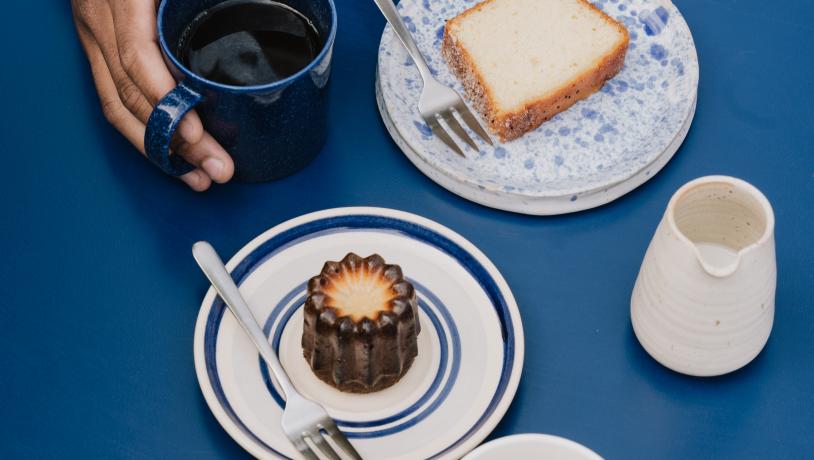
FORMAT at Designmuseum DanmarkPhoto:Luka Hesselberg
Food served in specially designed frames
As the gastronomic experience at the museum cafés has been elevated, so have the architectural surroundings at the cafés. In many of the museum cafés, architecture firms or interior designers have been involved in the redecoration of the cafés, leading to aesthetic, artistic and well-designed spaces.
Examples of re-designed museum cafés:
- Kafeteria at SMK – internationally recognised artist Danh Vo has designed the café's interior.
- Café Pegasus at Den Frie Udstillingsbygning – designed and decorated by architects Mathias Mentze and Alexander V. Ottenstein.
- Nikolaj Kunsthal café – Architecture firm MEE Studio has refurbished and designed the interior.
- Connie-Connie at Copenhagen Contemporary – conceptualized and designed by TABLEAU and Australian designer Ari Prasetya
- Bakkehusets Orangeri – the octagonal green orangery designed by Rønnow Architects.
- Brasserie Post in Enigma – museum of Communication – designed by the architecture firm Briq.
- Mondrups café at Ordrupgaard Museum – the café is located in the architectural, sculptural extension created by the internationally renowned architect Zaha Hadid.
- M/S Café at M/S Maritime Museum of Denmark – the renowned Danish architecture firm BIG has designed the underground museum.
Notable museum cafés in Copenhagen
Apollo Bar at Kunsthal Charlottenborg
In the courtyard of Kunsthal Charlottenborg by the harbour area of Nyhavn, you will find the simple café and restaurant Apollo Bar. Apollo Bar is both a café serving Copenhagen breakfast classics and a bar with wine, beer, snacks, and small dishes served in artistic surroundings. The place also works as the canteen for the students at The Royal Danish Academy of Fine Arts, which also resides in Kunsthal Charlottenborg. From Thursday to Saturday, Apollo Bar becomes more of a restaurant serving seasonal dishes depending on daily deliveries. Apollo Bar is created by Frederik Bille Brahe, who is also behind the successful café Atelier September and the museum café Kafeteria at The National Gallery of Denmark - SMK.
Connie-Connie at Copenhagen Contemporary
Connie-Connie, the café at Copenhagen Contemporary, is operated by the team behind the Italian restaurant Calma in Nørrebro. Connie-Connie offers a curated selection of dishes, including assorted sandwiches and uses fresh fish and plant-based options, complemented by an extensive list of natural wines. Guests can savour these in the café’s distinctive green setting. The space, a creative vision brought to life by TABLEAU and designer Ari Prasetya, initially showcased 25 bespoke stools and chairs, exploring how furniture itself can be considered art. This innovative approach to café seating was recognized with the Wallpaper Annual Design Awards Prize in 2022.
Kafeteria at The National Gallery of Denmark - SMK
Kafeteria was created by Copenhagen-based chef and restaurateur Frederik Bille Brahe with the ambition to create synergy between food and art - and to invite you to experience the food as a gateway to the history and art collection you’ll find at SMK. Art is the common thread between the museum and the café, whose interior is designed by internationally recognized artist Danh Vo, who has combined classic Danish furniture with exciting designs from Italy and Japan. The café has its own bakery and is especially known for its homemade cakes and pancakes, but it is also possible to enjoy seasonal dishes, snacks, and natural wine.
Lille Fugl at Gammel Strand
In the basement of the art museum Gammel Strand, you will find their café, Lille Fugl, an extension of the successful bakery, Flere Fugle, located in the neighbourhood of Nordvest. The bakery Flere Fugle opened in 2022 and quickly became a hotspot for Copenhageners, serving baked goods, sourdough bread, pastries, pizza, and coffee. Lille Fugl operates as the ‘little sister’ café with freshly baked produce from Flere Fugle. Besides serving quality baked goods and pastries, Lille Fugl also serves breakfast and lunch in addition to selling basic groceries like coffee, flour, and wine.
Café Pegasus at Den Frie
Café Pegasus, located at the contemporary art museum Den Frie Udstillingsbygning, is a meeting place and hub for artists, art professionals, passers-by, and the audience. The café has been designed and decorated by two architects, Mathias Mentze and Alexander V. Ottenstein, in line with the design of J.F. Willumsen, who was the original artist and architect behind the exhibition centre. Café Pegasus’ seasonal menu and broad selection of drinks can be experienced in original historic benches or in the two architects’ reproduction of Den Frie’s iconic wicker chair.
FORMAT at Designmuseum Denmark
Good, simple, and honest craftsmanship is the foundation of Designmuseum Denmark's café FORMAT. The café is located with direct access to the museum courtyard. The café serves breakfast, lunch, pastries, and coffee. The pastries are created by pastry chef Boglárka Megyesi, who is brought in from the popular bakery Andersen & Maillard. Boglárka honours the museum’s changing exhibitions by creating a cake specially made for their temporary exhibitions. The café part is run by head chef Brian Mondrup, who emphasizes fresh and local produce and creates dishes according to seasonal ingredients. Every Thursday, the doors to FORMAT are open a little longer when the café hosts "Thursday Dinner" serving a special à la carte menu.
Picnic at Glyptoteket
The museum café Picnic is located right by Glyptoteket’s picturesque Winter Garden and entails the possibility of having a picnic in the “open air” all year round. The Winter Garden is the envision of founder Carl Jacobsen who wanted it to be a place where people could disconnect from everyday life and enjoy art. Picnic is run by top chef Lasse Askov, who has great experience in Copenhagen’s food scene and received a Michelin star in 2009 at the restaurant Kokkeriet. At Picnic, he serves modern food and well-known classics with high-quality produce from local suppliers on menus that change with the seasons.
Nikolaj Kunsthal Café
The art museum Nikolaj Kunsthal is uniquely located in a former church and combines the building’s history and present status as a contemporary art gallery within its café. The café has been realised in collaboration with architect Morten Emil Engel, who runs the architecture firm MEE Studio. The space has been designed and executed in oakwood, from sustainable forestry and cobber referencing, respectively, the interior of the church and the characteristic cobber spire of Nikolaj Church. The furniture is also all designed specifically for the café, creating more recreational settings for the visitors. The café serves coffee, wine, and snacks, all chosen and selected in cooperation with the Danish brand Depanneur, which produces beverages inspired by convenience stores from Quebec in Canada, all with a local and organic focus.
Bakkehuset’s Organgeri
In the romantic garden of the house museum Bakkehuset in Frederiksberg, you can find its characteristic octagonal green Orangery. The Orangery is designed by Rønnow Architects and is inspired by a gazebo and Orangery that existed in the garden of Bakkehuset in the 16th century. Bakkehuset is an authentic home from the historical golden age and gives insight into the way of life in the 19th century, as well as its atmosphere and style. Bakkehuset’s Orangery takes a departure from this history and serves seasonal lunches based on historical recipes and methods but adapted to modern taste buds. It is accompanied by homebrewed schnaps, beer from microbreweries, and natural wine. The orangery is only open during the summer period.
Brasserie Post at Enigma – Museum of Communication
Brasserie Post is located in the former iconic post office building on Trianglen in Østebro , which now houses Enigma – Museum of Communication. The interior architecture and space plan is created by the architecture firm Briq. Brasserie Post is a French brasserie and wine bar that serves lunch and dinner and makes brasserie classics and modern interpretations of regional courses from the French country cuisine. It is American chef Dave Harrison, who is behind Brasserie Post. Harrison has previously worked as head chef at the bistro Au Passage in Paris, followed by Den Vandrette and Brasserie Prins in Copenhagen. Harrison creates menus depending on supply, working by the philosophy: What do we have to offer today and not what do we want to serve. Their wine card is likewise divided according to house and not colour, grape or region to give a better overview of the specific terroir.
DAC Café at DAC
At the café at Danish Architecture Center, DAC, you can combine a coffee, cake or a piece of smørrebrød with great views of the Copenhagen harbour and its historic and iconic buildings and architecture. The café is located on top of the BLOX building. It has panoramic windows and three rooftop terraces with parasols and glass pavilions that allow you to experience the view all year round. The menu at the café reflects a green, Nordic kitchen using seasonal ingredients focusing on animal welfare and organic produce.
Notable museum cafés around Copenhagen
Mondrups at Ordrupgaard Museum
Ordrupgaard is an art museum located just north of Copenhagen. Besides showcasing a great collection of international art and exhibitions, Ordrupgaard Museum is also home to innovative architectural extensions and the house of furniture designer and architect Finn Juhl. Their café Mondrups at Ordrupgaard is in the architectural extension by renowned architect Zaha Hadid. Zaha Hadid’s extension to the original mansion, built in classicist style, lies like a sculpture. Its large glass windows give visitors great views of the idyllic garden and its many contemporary, interactive artworks. The café serves Nordic food like smørrebrød, baked goods, and cakes made from fresh produce.
Madam Carlsen’s Café & Bistro at Karen Blixen’s museum – Rungstedlund
The former home of the renowned Danish author Karen Blixen is now a museum in Rungstedlund North of Copenhagen, you can enjoy a view of the sound or the museum’s garden and unique bird reservoir at their café and bistro Madam Carlsen’s. The name derives from Madam Caroline Carlsen, Karen Blixen’s long-time housekeeper and chef, who had her residence in the space where the café is located today. Madam Carlsen’s Café & Bistro serves breakfast, smørrebrød for lunch, afternoon tea, cakes, and dinner. The food is made from organic ingredients and as much fresh produce as possible, where you can even experience that their meat comes from their grazing cows, honey from their bees, and herbs and fruit cut from their garden. Additionally, the café only serves coffee and sodas imported from local nearby suppliers.
M/S Café at M/S Maritime Museum of Denmark
At the M/S Maritime Museum of Denmark, the maritime theme is not only applied in their exhibitions but also recurs in their café. Here, you can enjoy Nordic food like homemade smørrebrød, homemade fish cakes, several kinds of herring, salads, or something for the sweet tooth, everything created from quality produce. You can also assemble your own lunch of fish from the sustainable assortment of preserves of the highest quality from Grøndals, such as sardines, mackerel, or tuna. The café is run by head chef Nicolai Byrholt Garre, who has previously been a chef at the Michelin-starred restaurant Søllerød Kro. The M/S Café is located under ground with panoramic windows that give you a view of the historic dry dock and architecture by the Danish architectural firm BIG. In the summertime, the dock turns into the café’s terrace.
Øregaard Café at Øregaard Museum
At Øregaard Museum in Hellerup, just north of Copenhagen, you can experience Danish art and changing exhibitions combined with a lunch or homemade pastries and cakes in their garden overlooking the romantic-designed park Øregaardsparken. The country estate Øregaard and the adjoining Øregaards park were designed by the French architect Joseph-Jacques Rameé in 1808 to house the grocer Johannes Søbøtker and his family. Øregaard’s permanent collection contains 200 years of Danish art, with every piece connected to the area around the museum north of Copenhagen.

Senior Manager – Press & PR

